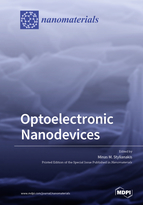Optoelectronic Nanodevices
A special issue of Nanomaterials (ISSN 2079-4991).
Deadline for manuscript submissions: closed (30 November 2018) | Viewed by 114634
Special Issue Editor
Interests: graphene; 2D nanomaterials; metal oxides; materials science; chemistry; energy applications; organic photovoltaics; perovskite solar cells
Special Issues, Collections and Topics in MDPI journals
Special Issue Information
Dear Colleagues,
Over the last decade, graphene and beyond graphene nanomaterials (TMDs, Xenes) have centralized the interest of the scientific community, due to the extraordinary physical, optical, thermal, and electrical properties, which are correlated with their two-dimensional (2D) ultrathin atomic layer structure, large interlayer distance, ease of functionalization, as well as tunable bandgap. Therefore, potential applications in the fastest growing fields of energy (photovoltaics, energy storage, fuel cells, hydrogen storage, catalysis, etc.), electronics, photonics, spintronics and sensing have been developed. The continuous nanostructure-based applications development offers the confidence to significantly improve existing products and to enable the design of materials and devices with novel functionalities.
We invite investigators to submit original research articles, letters, as well as review articles and perspective views, on fundamental studies and optoelectronic applications of nanomaterials. The present Special Issue of Nanomaterials focuses on new insights demonstration, as well as the potential and challenges in the realization of various efficient optoelectronic devices, such as solar cells (OSCs, PeSCs), light emitting diodes (LEDs), sensors, photodetectors, etc., upon the incorporation of nanostructured materials.
Dr. Minas M. Stylianakis
Guest Editor
Manuscript Submission Information
Manuscripts should be submitted online at www.mdpi.com by registering and logging in to this website. Once you are registered, click here to go to the submission form. Manuscripts can be submitted until the deadline. All submissions that pass pre-check are peer-reviewed. Accepted papers will be published continuously in the journal (as soon as accepted) and will be listed together on the special issue website. Research articles, review articles as well as short communications are invited. For planned papers, a title and short abstract (about 100 words) can be sent to the Editorial Office for announcement on this website.
Submitted manuscripts should not have been published previously, nor be under consideration for publication elsewhere (except conference proceedings papers). All manuscripts are thoroughly refereed through a single-blind peer-review process. A guide for authors and other relevant information for submission of manuscripts is available on the Instructions for Authors page. Nanomaterials is an international peer-reviewed open access semimonthly journal published by MDPI.
Please visit the Instructions for Authors page before submitting a manuscript. The Article Processing Charge (APC) for publication in this open access journal is 2900 CHF (Swiss Francs). Submitted papers should be well formatted and use good English. Authors may use MDPI's English editing service prior to publication or during author revisions.
Keywords
- Nanomaterials
- Optoelectronic devices
- Light Emitting Diodes
- Solar Cells
- Electronics
- Photonics







